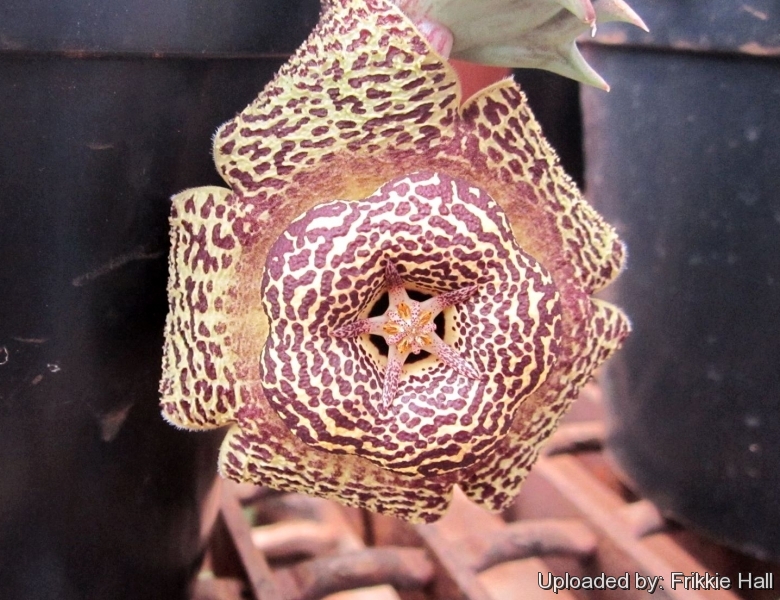
Orbea namaquensis Photo by: Frikkie Hall
Origin and Habitat: Orbea namaquensisSN|32964]]SN|32964]] is restricted to Namaqualand (Northern Cape) in the northwestern corner of South Africa where it can become locally quite common.
Habitat and ecology: It growos together with a rich succulent flora comprising Stapelia pulvinata, Stapelia barklyi, Bulbine praemorsa, Tylecodon wallichiiSN|17354]]SN|17349]], Tylecodon racemosus, Tylecodon reticulatusSN|17349]]SN|17354]], Lampranthus hoerleianus, Antimima radicans, and Ottosonderia monticola.
Synonyms:
See all synonyms of Orbea namaquensis
back
Accepted name in llifle Database:Orbea namaquensis (N.E.Br.) L.C.LeachKirkia 10: 290 1975Synonymy: 8
back
Common Names include:
ENGLISH: Namaqua orbea
Description: Orbea namaquensisSN|19768]]SN|32964]], firstly described as Stapelia namaquensisSN|32965]]SN|32965]] by N. E. Brown in 1882, is a leafless perennial forming small clumps or mats. The stems are very similar to those of Orbea ciliataSN|23062]]SN|23062]] with stout conic teeth loosely arranged in 4 rows, but the flowers are different. 1-4 flower up to 10 cm in diameter are produced in succession on lower stem, inside they are irregularly transversely ridged, pale greenish yellow, irregularly marked with dark purple-brown. The annulus almost as wide as limb, is finely tuberculate, with margin completely recurved. This species appear to be very variable in colour, ciliation and outer corona-lobes as the related Orbea variegataSN|32964]]SN|19768]], from which it mainly differs in the internal flower structures and the annulus.
Stems: Short, stout, sometimes almost cylindrical, 4-8 cm long, 15-18 mm thick, excluding the teeth, squat, shortly prostrate and then decumbent, distinctly 4-angled. Tubercles (teeth) stout, 3-10 mm long, spreading,conical, acute, glabrous, green, prettily marked with irregular purple stripes where exposed to the sun.
Leaves: Rudiments hardened.
Inflorescences: 1- to 4-flowered, near the base or middle of the young stems. Flowers successively developed.
Flowers: Pedicels, glabrous, striped with darker purple-red, 2 mm long, 0.5 mm in diameter. Sepals 4-6 mm long, 2.5 mm, ovate, acuminate, glabrous. Corolla in bud depressed-pentagonal with a very acuminate point, when expanded 7.5 - 10 cm across, basin-shaped, tube embracing the corona, shortly hairy at the base, pale greenish-yellow, vertically broadly streaked with dark red-brown, partly marked with confluent spots or reticulate. Annulus large, almost as wide as limb, very prominent solid-looking, fleshy, margin extremely recurved or revolute so as to be nearly circular in transverse section, and the bottom of its cup densely covered with short erect stiff purple-brown hairs and minutely tuberculate-rugose. Back smooth and glabrous. Corolla-lobes 3 x 2.5 cm, divaricate, revolute, not ciliate or sometimes finely ciliate, inner surface plicate-rugose or papillose, papillae, pale greenish-yellow, everywhere covered with dark purple-brown thick transverse lines or rounded or transverse or confluent spots or labyrinthine markings.
Corona yellow with red-brown spots. Outer corona-lobes elongate-rectangular, 6-8 mm long, 1.5 mm wide, ribbon-like, spreading then ascending, attenuate entire to trifid , acute, yellow, dotted with purple-brown. Inner corona-lobes 3.5-5 x 1 mm, narrowly ovate, erect, apical appendage filiform, clavate, overtopping the style head, sometimes tips revolute, partly with a dorsal hump, but without an outer horn. Nectar slit drop-shaped. Pollinia 0.8 x 0.5 min, bean-shaped.
Blooming season: Summer-autumn and the flowers remain expanded for 3–4 days.
Fruits (follicles): to 15 cm, 1,8 cm thick, subparallel, fusiform, acuminate, glabrous.
Chromosome number: 2n = 22
Bibliography: Major references and further lectures
1) Focke Albers, Ulrich Meve “Illustrated Handbook of Succulent Plants: Asclepiadaceae: Asclepiadaceae”Volume 4 Springer, 2002
2) N. E. Brown “Flora Capensis” Vol 4, 1909
3) “Hooker's Scones Plantarum” 1908 (1890)
4) Lückhoff “The Stapelieae of southern Africa” 153 (1952)
5) Lamb & Lamb, “Illustrated reference on cacti and other succulents” 3: 881 (1963)
6) Court, “Succulent flora of southern Africa” 141 (1981)
7) James Cullen, Sabina G. Knees, H. Suzanne Cubey “The European Garden Flora Flowering Plants: A Manual for the Identification of Plants Cultivated in Europe, Both Out-of-Doors and Under Glass” Cambridge University Press, 11 August 2011
8) Ernst Van Jaarsveld, Ben-Erik Van Wyk, Gideon Smith “Succulents of South Africa: A Guide to the Regional Diversity”Tafelberg, 2000
9) John Manning “Field Guide to Wild Flowers of South Africa, Lesotho and Swaziland” Struik Nature, 2009
10) Matlamela, P.F. & Kamundi, D.A. 2006. Orbea namaquensis (N.E.Br.) L.C.Leach. National Assessment: Red List of South African Plants version 2015.1. Accessed on 2016/05/20
11) F. Albers and U. Meve “Mixoplidy and cytotyped: a study of possible vegetative species differentiation in stapeliads (Asclepiadaceae)” Bothalia 21(1): 67-72 (1991)
Cultivation and Propagation: Orbea namaquensisSN|32964]]SN|32964]] is one of the easiest stapeliads to grow. It like a half-sun or shaded position (never grow in too harsh sun), very resistant to heat will also tolerate quite cold temperatures but avoid frost, best in a ventilated environment. It is quite resistant to the “Balck spot” disease of Asclepiads, Water regularly during the growing season, keep dry in winter. Use a gritty, well-drained soil.
Propagation: It is easily propagated by removing a cutting, sometimes with roots attached, in spring and summer, but seeds germinate readily if they are sown when fresh.










